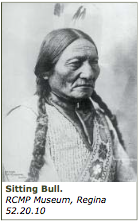
Sitting Bull, Chief of the Hunkpapa Sioux, was born in 1836 in Dakota Territory. Under Chief Red Cloud, Sitting Bull was one of the leaders who fought against American movement into Sioux territory in the 1860s. In the early 1860s the Sioux were granted the Black Hills of South Dakota under Treaty; however, the early 1870s saw reports of gold and the area was flooded with white prospectors. The conflict reached a climax on June 25, 1876, with the Battle of the Little Big Horn, in which the Sioux led by Sitting Bull defeated George Custer and the 7th U. S. Calvary. In November 1876 Sitting Bull crossed the international boundary into Canada and sought refuge in the Cypress Hills near Wood Mountain. There he was met by James Walsh of the North-West Mounted Police, who assured the chief that he would be protected from attack by the US Cavalry as long as he obeyed the laws of Canada and did not make raids into the US—terms that Sitting Bull agreed to.
Between 1877 and 1881 numerous attempts were made by both American and Canadian officials to have Sitting Bull return to the US. He had hoped to remain in Canada, but Canadian officials were not willing to grant him a reserve or provide rations. As a result, in July 1881 Sitting Bull, accompanied by the Wood Mountain fur trader Jean-Louis Légaré, surrendered to American officials at Fort Buford, North Dakota. Sitting Bull took up residence on the Standing Rock Agency and for a time toured with Buffalo Bill’s Wild West Show. In December 1890 he was shot and killed by a group of Indian police who were attempting to issue a warrant for his participation in the Ghost Dance.
Rob Nestor

